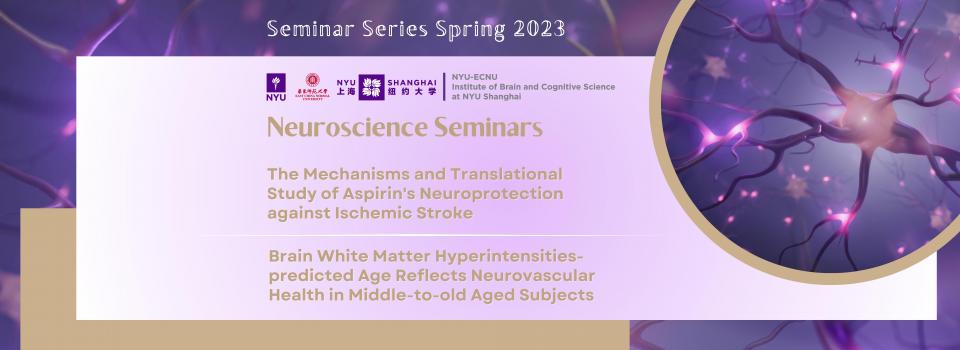
Host: Prof. Xing Tian, NYU Shanghai
- RSVP to Join the Seminars Online or Onsite -
Agenda
13:00-14:00
Talk title: The Mechanisms and Translational Study of Aspirin's Neuroprotection against Ischemic Stroke
Speaker: Prof. Dong-Min Yin, East China Normal University
Biography
Yin lab focuses on the mechanistic and translational study of neural plasticity and neuroprotection. Neural plasticity refers to the adaptive changes of the structure and function of the nervous system with the changes of internal and external environment. Neural plasticity can occur at the synaptic and cellular levels, including changes in synaptic transmission and changes in nerve cell excitability. Neural plasticity is a necessary condition for normal physiological function of the body, and the abnormal neuroplasticity is closely related to the occurrence of schizophrenia and other mental diseases.
Abstract
Ischemic stroke is a major cause of mortality and disability worldwide. Antithrombotic agents represent a major advance in the prevention and treatment of ischemic stroke in clinic. Aspirin (acetylsalicylate, a first-line anti-coagulant) is widely used for secondary prevention of ischemic stroke and heart diseases. However, like all existing antithrombotic medicine, aspirin may increase bleeding risks and cause brain hemorrhage.
Here we used unbiased proteomics approaches to identify an anti-coagulation-independent and neuronal mechanism underlying the neuroprotective effects of aspirin against ischemic stroke in mice. Based on the mechanistic findings, we further developed a modified aspirin that exhibits less bleeding risks than regular aspirin but retains the neuroprotective effects against ischemic stroke in mice. This study will have significant contribution to the prevention or treatment of ischemic stroke not only mechanistically but also translationally.
14:00-14:20: Tea break
14:20-15:20
Talk title: Brain White Matter Hyperintensities-Predicted Age Reflects Neurovascular Health in Middle-To-Old Aged Subjects
Speaker: Prof. Chu-Chung Huang, East China Normal University
Biography
Chu-Chung Huang’s research focuses on depicting brain structural and functional aging trajectories using non-invasive magnetic resonance imaging techniques. Given that the brain structure is fundamental to cognitive function, it is important to understand the interaction between gray matter, as the information processing units, and white matter, as the signal pathways. A deeper understanding of brain structural connectome might provide insight into cognition, as well as the development of neurodegenerative diseases and mental illness. Therefore, Dr. Huang’s primary research goal is to integrate the most advanced neuroimaging methods, including cortical morphometry, diffusion MRI, and quantitative imaging techniques, to reconstruct the human brain networks and related metrics as the probe for brain performance, with the aim of providing objective biomarker for brain health status evaluation at different stages of human lifespan.
Abstract
Age-related neurovascular structural and functional impairment is a major aetiology of dementia and stroke in older people. There is no single marker representative of neurovascular biological age yet. Given the close relationship with ageing and age-related neurovascular changes, we aims to develop and validate a white matter hyperintensities (WMH)-based model for characterising individuals’ neurovascular biological age. In this prospective single-site study, the WMH-based age-prediction model was constructed based on WMH volumes of 491 healthy participants (21–89 years). In the training dataset, the constructed linear-regression model with log-transformed WMH volumes showed well-balanced complexity and accuracy (root mean squared error, RMSE = 10.20 and mean absolute error, MAE = 7.76 years). This model of neurovascular age estimation was then applied to a middle-to-old aged testing dataset (n = 726, 50–92 years) as the testing dataset for external validation. The established age estimator also had comparable generalizability with the testing dataset (RMSE = 7.76 and MAE = 6.38 years). In the testing dataset, the WMH-predicted age difference was negatively associated with visual executive function. Individuals with older predicted-age for their chronological age had greater cardiovascular burden and cardiovascular disease risks than individuals with normal or delayed predicted age. These associations were independent of chronological age. Our model is easy to use in clinical practice that helps to evaluate WMH severity objective to chronological age. Current findings support our WMH-based age measurement to reflect neurovascular health and have potential diagnostic and prognostic value for clinical or research purposes in age-related neurovascular disorders.


